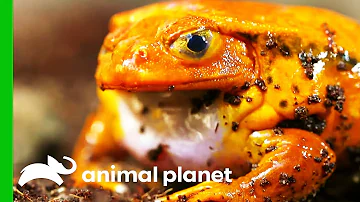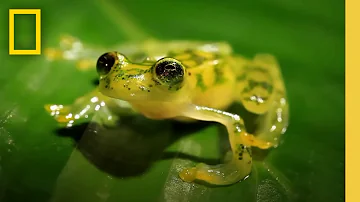
Tomato Frog
Dyscophus antongilii

Meet the Tomato Frog
The Tomato Frog is a striking amphibian native to Madagascar, easily recognized by its vibrant red or orange coloration reminiscent of a ripe tomato. It inhabits humid lowland forests, swamps, and areas near slow-moving freshwater bodies. When threatened, the Tomato Frog can secrete a sticky, toxic substance from its skin to deter predators. These frogs are nocturnal and spend much of their time hidden under leaf litter or in burrows, emerging mostly during the rainy season. Their bright coloration serves as a warning to potential predators about their toxicity.
Classification
Amphibian
Habitat
Tropical lowland forests and freshwater swamps
Diet
Carnivore
Lifespan
6-8 years
Conservation
Near Threatened
Weight
40-200 grams
📖Fascinating Facts
Tomato-Like Color
The Tomato Frog's bright red or orange skin is a form of aposematic coloration, warning predators of its toxicity.
Skin Secretion
When stressed, the Tomato Frog secretes a white, sticky toxin from its skin that can deter predators and cause irritation.
Female Dominance
Female Tomato Frogs can grow up to four times larger than males and are more vividly colored, which helps protect their eggs.
📋Detailed Description
The Tomato Frog (Dyscophus antongilii) is a robust, medium-sized amphibian, with adult females reaching up to 10.5 cm in length and weighing as much as 230 grams, while males are significantly smaller, averaging 6–7 cm. Its skin is smooth and moist, with a vivid red to orange dorsal coloration, and a paler, sometimes yellowish ventral side. This aposematic coloration serves as a warning to predators of its toxic skin secretions. The frog has a rounded body, short limbs, and a broad, flat head with prominent eyes and a relatively small mouth. Tomato Frogs are primarily terrestrial, spending much of their lives hidden in leaf litter or shallow burrows, emerging mainly during periods of heavy rainfall. They are nocturnal and solitary, except during the breeding season when they congregate in temporary pools. Their diet consists mainly of invertebrates, including insects, worms, and small arthropods, which they capture using a rapid flick of their sticky tongue. The species is known for its defensive behavior: when threatened, it inflates its body and secretes a thick, sticky, and mildly toxic mucus that can cause irritation in predators and humans. This adaptation, combined with their bright coloration, provides effective protection. Tomato Frogs have a relatively slow metabolism and can survive periods of drought by burrowing and entering a state of torpor. Their vocalizations, especially during the breeding season, consist of low-pitched, repetitive calls that can carry over long distances in their swampy habitats.
💡 Did you know?
Tomato Frogs can inflate their bodies to appear larger and more intimidating when threatened.
🔬Research & Sources
Wikipedia Summary
Tomato frogs are any of the three species of genus Dyscophus : D. antongilii, D. insularis, or D. guineti. Dyscophus is the only genus in subfamily Dyscophinae. They are endemic to Madagascar.
Last Modified: 3/28/2025
🎭Behavior & Social Structure
Tomato Frogs are primarily nocturnal, remaining inactive and concealed during the day under leaf litter, logs, or in shallow burrows to avoid desiccation and predation. At night, they become active hunters, using a sit-and-wait strategy to ambush prey. Their diet is opportunistic, consisting of a variety of invertebrates such as beetles, ants, termites, spiders, and earthworms. They rarely climb and are considered poor jumpers, relying instead on short hops and crawling movements. Social interactions are minimal outside of the breeding season, as individuals are highly territorial and may display aggressive behaviors if threatened by conspecifics. During the rainy season, males become more vocal, emitting a series of deep, resonant croaks to attract females and establish breeding territories. Tomato Frogs are generally solitary, except during breeding aggregations, and exhibit little to no parental care after egg-laying.
👶Reproduction & Life Cycle
Breeding in Dyscophus antongilii is closely tied to the onset of the rainy season, typically from November to March. Males congregate in shallow, temporary pools and call to attract females. Amplexus is axillary, with the male grasping the female behind her forelimbs. Females lay between 1,000 and 1,500 eggs in a single clutch, which are deposited in surface films of water. The eggs are small, black and white, and float on the water surface. Embryonic development is rapid, with hatching occurring within 36–48 hours, depending on temperature. Tadpoles are filter feeders, consuming detritus and microorganisms, and undergo metamorphosis into juvenile frogs within 30–45 days. There is no parental care post-oviposition, and survival rates are highly dependent on environmental conditions and predation pressure.
🛡️Adaptations & Survival
The Tomato Frog exhibits several notable adaptations for survival in its humid, lowland forest environment. Its bright red-orange coloration serves as aposematic signaling, warning predators of its toxic skin secretions, which contain alkaloids and proteins that can cause numbness or irritation. The frog's skin is highly glandular, allowing for rapid secretion of mucus when threatened. Its burrowing behavior and nocturnal activity help reduce water loss and avoid diurnal predators. The ability to enter a state of torpor during dry periods allows it to survive seasonal fluctuations in water availability. Morphologically, its robust body and short limbs are well-suited for terrestrial life and burrowing, while its sticky tongue is specialized for capturing fast-moving prey. The species' reproductive strategy of explosive breeding in temporary pools helps ensure offspring survival by reducing predation and competition.
🎨Cultural Significance
The Tomato Frog is a symbol of Madagascar's unique biodiversity and is often featured in environmental education and ecotourism materials. While not traditionally used in Malagasy folklore or medicine, its striking appearance has made it a flagship species for conservation campaigns. The frog's image is sometimes used in local art and crafts, and it serves as an ambassador species for the protection of Madagascar's threatened amphibian fauna.
🔬Recent Research & Discoveries
Recent research on Dyscophus antongilii has focused on its chemical defenses, with studies identifying novel peptides and alkaloids in its skin secretions that may have pharmacological applications. Genetic studies have clarified the phylogenetic relationships within the genus Dyscophus and highlighted the need for conservation of genetically distinct populations. Ongoing field studies are monitoring population trends, habitat use, and the impacts of environmental change. Captive breeding programs, both in Madagascar and internationally, have contributed valuable data on reproductive biology and husbandry, supporting ex situ conservation efforts.
🎥Wildlife Videos

Wildlife of Tomato Frog |World Wild Life
Wildlife of Tomato Frog |World Wild Life #national#rehabilitator#biography#documentary#wildlifemanagment ...
Animals World.official

The FORBIDDEN Tomato - Tomato Frog - Animal a Day
Today we learn about the fruity frog that might just jump out of that salad you're eating, the Tomato Frog. Join this channel to get ...
Animal a Day

Testing The Incredible Capabilities Of The Tomato Frog | Little Giants
The bright red tomato frog has several impressive powers, including incredible digging speed and a super sticky defence ...
Animal Planet

Tomato Frog (Dyscophus species)/ Madagascar
The Tomato Frog (Dyscophus species) is a distinctive amphibian native to Madagascar, known for its vibrant red-orange ...
Wildlife Israel Yuval Dax

The Glass Frog: Ultimate Ninja Dad | Animal 24
About National Geographic: National Geographic is the world's premium destination for science, exploration, and adventure.
National Geographic

Tomato frog || tomato frog care || tomato frog lifespan || tomato frog habitat
Tomato frogs are any of the three species of genus Dyscophus: D. antongilii, D. insularis, or D. guineti. Dyscophus is the only ...
The Zoological World
🌍Habitat Information
The Tomato Frog typically inhabits Tropical lowland forests and freshwater swamps environments. Tomato Frogs have adapted to their environments with specialized features and behaviors.
Primary Habitat:
Tropical lowland forests and freshwater swamps
More detailed habitat information will be available soon.
🛡️Conservation Status
The Tomato Frog is currently classified as Near Threatened. Conservation efforts are crucial for preserving this species for future generations.
Common Threats:
- 🏠Habitat loss and fragmentation
- 🌡️Climate change impacts
- 🎯Hunting and poaching
- 🏭Human-wildlife conflict
⚠️Threats & Conservation Challenges
Dyscophus antongilii faces a range of threats, primarily habitat loss due to deforestation, agricultural expansion, and urbanization in Madagascar. Pollution of breeding sites and water bodies further impacts reproductive success. The species is also subject to collection for the international pet trade, although regulated export quotas have been implemented. Invasive species and climate change, which alter rainfall patterns and water availability, pose additional risks. While some populations remain stable in protected areas, overall numbers are believed to be declining, leading to its Near Threatened status on the IUCN Red List. Conservation challenges include enforcing habitat protection, regulating trade, and mitigating the effects of environmental degradation.
🔬Scientific Classification
Scientific Name
Dyscophus antongilii
Classification Hierarchy
🔍 About Taxonomic Classification
Taxonomic classification is a hierarchical system used by scientists to classify and organize living organisms based on shared characteristics and evolutionary relationships.
The system moves from broad categories (Kingdom) to increasingly specific ones, with each animal's scientific name typically consisting of its Genus and species.
📝Community Notes
Share your observations and insights about the Tomato Frog with our community of wildlife enthusiasts.
Join Our Community
Sign in to share your observations and connect with fellow wildlife enthusiasts.
Sign In to ContributeNo community notes yet
Be the first to share your observations about the Tomato Frog!
Explore Tomato Frog
Select a tab above to learn more about this amazing animal.
📸Photo Gallery
No photos available for this animal yet.
🌟Discover More Wildlife
Continue your journey of discovery with more fascinating animals from our database
